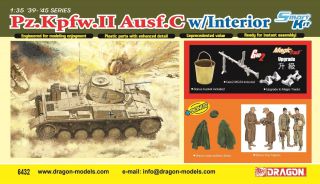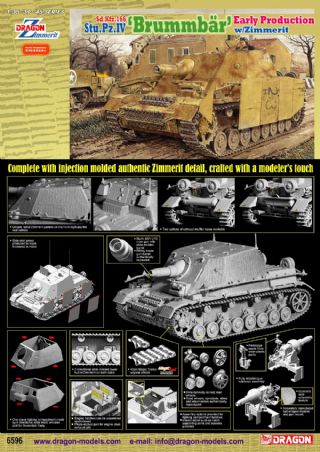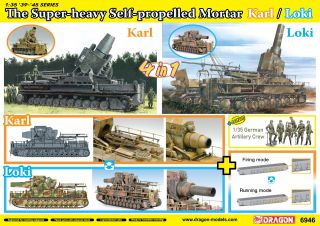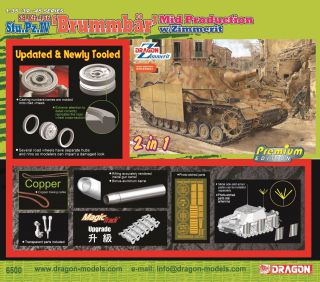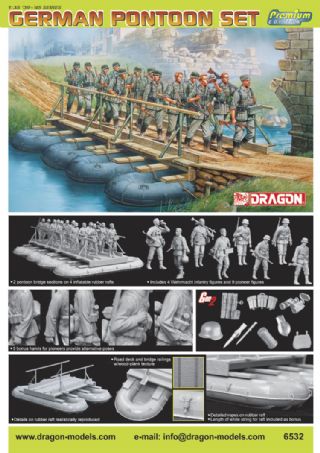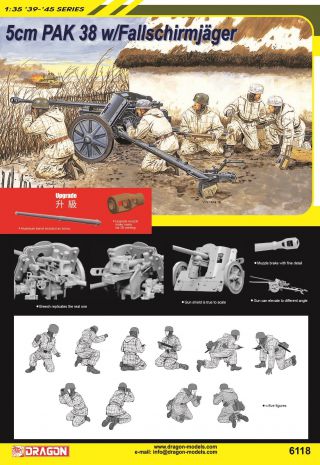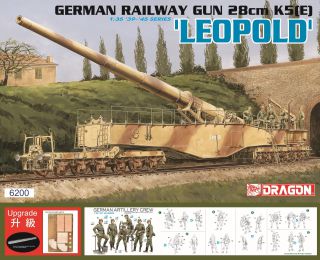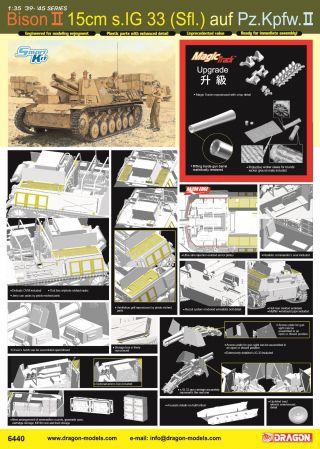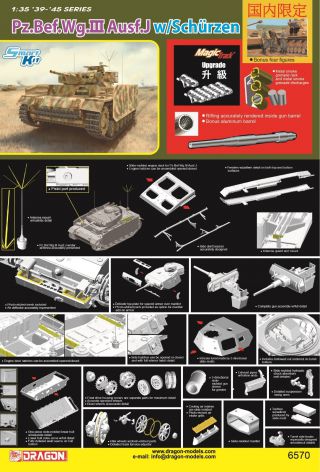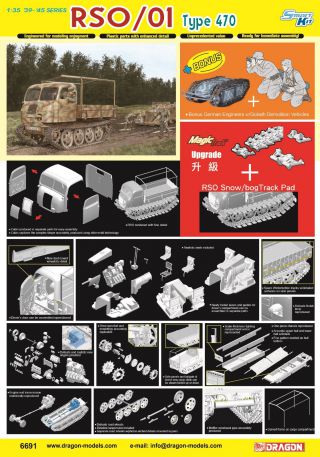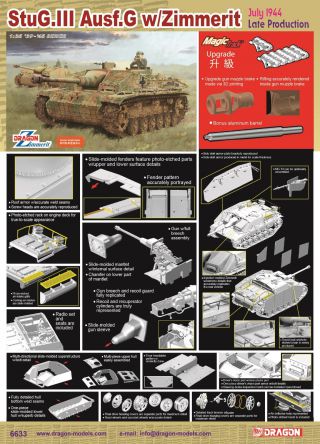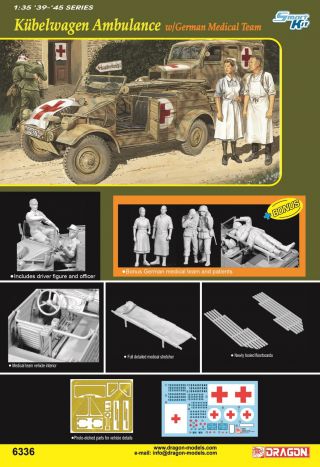HOME → Dragon Plastic Model Kits → 1/35 WWII Military → 6675
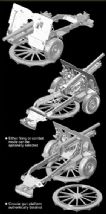


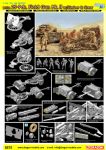




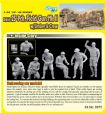
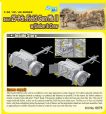
Barcode: 0 89195 86675 2
Case pack: 20 Pieces per carton
Box Size: 9.6" x 15" x 2.4"
Features:
- Newly tooled 6 realistic 1/35 scale figures w/optional poses
- Brand new 25-Pdr. Field Gun Mk. II w/Limber
- Either firing or combat mode can be optionally selected
- Circular gun platform authentically detailed
- Detailed limber doors can be assembled open/closed
- Ammo box can be optionally installed
- Moveable breech mechanism
- Gun recoils can be pulled back and forth
- Ammo box w/photo-etched parts installed
- Ammunition w/separate parts
- Aluminum barrel w/hollow muzzle
- Gun shield molded w/rivet detail
- Components allow gun to elevate
- Includes tool boxes on gun trails
- Gun cradle and hand wheels w/well-defined details
- Beautifully detailed slide-molded gun trails
- Crisp rivet detail incorporated
- Separate tools are fully reproduced
- Nuts sharply represented on road wheels
- Tires made from DS
Known officially as the “Ordnance QF 25 pounder”, this artillery piece was the workhorse of British and Commonwealth field artillery units during WWII. The name came from the fact that the weapon fired a 25-pound shell, and “QF” stood for “Quick Firing”. The 25-pdr entered service in 1940, and many consider it the best towed field gun of the war owing to its high rate of fire, lethal shell and good mobility. A total of 13,000 25-pdr guns were built worldwide, with the Mark II being the most common variant used in WWII. For transport, the 1,633kg howitzer was often hitched to an ammunition limber (known as the “Trailer, Artillery, No 27”) containing 32 rounds. Both pieces were then typically towed by a 4x4 Field Artillery Tractor. The six-man gun crew comprised the detachment commander, breech operator, layer, loader and two ammo handlers.
Dragon is offering a fantastic new kit of this famous British field gun. The model depicts the standard 25-pdr Mark II version. The 1/35 scale miniature was carefully researched using original guns as references, thus giving the model unparalleled levels of accuracy. Not only is the gun precisely dimensioned and detailed, but as a Smart Kit it offers an excellent balance of easy assembly. Wherever possible, components are separated into as few pieces as possible thanks to the widespread employment of slide-mold technology. Furthermore, the gun comes with its associated ammunition limber. This limber features two open doors that open to reveal the interior ammo storage trays. The storage area is faithfully reproduced and extremely easy to assemble. As if that isn’t enough, Dragon also provides a complete gun crew of six men. As their uniforms and state of dress shows, they are perfect for a North African diorama scene. All in all, this is the definitive 25-pdr kit for modelers.
Reviews
25 Pdr. Field Gun Mk.II w/Limber & Crew
Manufacturer: Dragon models
Scale: 1/35
Material: Styrene & PE
Serial Number: 6675
Price: TBA
Introduction
The 25 Pdr. Was considered by many to be the best field artillery piece of WWII, despite being underpowered when compared to other guns towards the latter part of the war.
This new kit from Dragon depicts the Mark II, that started to be delivered and used in 1940.
Kit Contents
This kit arrives in the standard full-sixe kit box, and yet the contents do seem rather sparse when compared with more recent Dragon releases. Of course, since it's a model of a relatively small field gun, albeit with crew, it's something we should have expected, but would probably have been better supplied in one of their 'generation 2' box sizes similar to their recent M2A1 howitzer.
Inside the slightly over-size box then, we're supplied with two large sprues, and two smaller ones, plus a figure sprue, photo-etched brass fret and small decal sheet. The instructions in the kit consist of just four sides of their normal sized instructions, which include the assembly instructions for the figures.
The instructions begin with the figures, by way of a labelled black and white reproduction of the six assembled figures across the top of the second page of instructions before assembly of the gun begins. All the necessary poses are present to depict the gun in the act of firing the gun. All six figures are wearing shorts and steel helmets, with four of the figures wearing no shirt, so there'll be a fair bit of work getting the arms 'seamless', since each of the torsos that are bare-chested have the upper parts of their arms moulded integrally with the torso. There'll also be the join between the figures head and neck to conceal, since of course, there isn't the usual collar to help!
Once the figures are complete, construction of the gun begins with the assembly of the trails and wheels. Unusually, each of the trail legs is supplied as a one-piece slide-moulded part, instead of the more usual method of joining two halves together to get the maximum amount of detail. Of course, this is partly due to the thickness of each of the trails, but also due to Dragon's technique of avoiding ejector pin marks. Not one...either side. How do they do that? More importantly I suppose....why doesn't everybody else do that? Each of the trails is covered in fine rivet detail, as was the real thing of course, and there are various details to be added between the two legs, such as structural cross members and the spade, along with smaller details fixed to each of the trails such as the platform travelling clamp, gunner's seat etc.
Each of the wheels, including the two for the limber are made from injection moulded hubs, inside wall insert and DS100 tan-coloured vinyl for the tyre itself, which can be cemented and treated in exactly the same way as normal rigid styrene.
The actual gun itself is next. The main barrel of the gun is supplied in two sections, not halves, meaning that there's no seam to disguise. These sections have also taken advantage of slide-moulding so that the end is pre-drilled to a depth of about 5mm. The breech block is supplied in two halves too, and any join in this area will be extremely visible, so be prepared for some work to make it invisible! The straight main shield is moulded extremely thinly, and again, through the clever application of nodes, it's been moulded with lots of detail on both sides with nary a sign of an ejector pin! Once the gun and carriage are complete, the sub-assemblies can be mounted to the firing platform. The option of having the gun in towed or firing mode is described on the instructions, and involves fitting one of two alternative mounting/fixing brackets between the carriage and the firing platform.
The final part of the build is the assembly of the limber. This is basically a box made from a number of flat sections to represent walls, floor and lid which fits onto a cross-member that connects two fenders. On to the front of the box is fixed the towing arm, a wheel either side, and then to the rear of the limber. Here we're offered either closed or open doors. If you decide to go with the open doors, then you have a one-piece fascia with ammunition drawer detail moulded in place, but with two drawers omitted. These two drawers are provided as separate parts, which can be detailed with photo-etched parts and then either closed to resemble the rest of the fascia or left open for added detail. The supplied photo-etched drawer fronts are slightly differently detailed than their plastic counterparts though, so leaving the open would appear to be the best option to prevent them standing out.
Conclusion
It's a superbly moulded kit that modeller's will really enjoy building! I have to say though, with current developments 'elsewhere', I can't help but feel that Dragon have missed a trick here in terms of that ammunition limber. Sixteen separate drawers and some extra ammunition would have made this good kit into a 'great' kit!
- Vinnie Branigan
DR6675: British 25 Pdr Field Gun Mk. II with Limber & Crew
1/35 injection plastic kit with crew
The Mark II version of the British 25-pounder was the backbone of the Commonwealth field artillery during WWII seeing service in all major theatres. The Mark II version of the Ordnance QF 25 pounder, entered service in 1940 and was used through out WWII and well into the post war period. It was typically towed by a 4x4 truck the “Quad’ along with a limber which also carried ammunition. The early production Mark II did not have a muzzle break which was added in 1942.
Overview
This model depicts an early production Mark II typical of those made from 1940 to 42 and used to rebuild the Commonwealth forces following the heavy loss of equipment in France. The kit includes the six man detachment in action and the limber. The limber was towed between the Quad and the field gun. Limbers were also towed in tandem pairs behind a Quad to provide reserve ammunition..
This kit features all new tooling and is in the Smart Kit format. The new tooling
is crisp and benefits from slid-molded detail. A small PE fret provides fine
detail including the ammunition boxes in the limber and mud flaps on the limber’s
wheel arches.
The gatefold instruction sheet has 11 steps of line drawings that are well laid
out. This combined with the well thought out design will ensure it will be rewarding
to a broad range of modelers.
Contents
The 25 pounder comes with its carriage, platform and gun shield. It is tooled in the Smart Kit format and offers you choices in how to build the gun. The gun can be modeled in the full range of elevations, and in action or transport.
The barrel is made from slide molded injection plastic and tooled so that the joint is hidden where the two parts of barrel met. It sits on a multi-part cradle which offers the choice of an early rivet design or later welded one. The breech can be shown open or closed, which is important given the option of making the kit with the crew in action. Other parts provide detail for the hand wheels, elevation mechanisms, sights etc.
The gun’s shield is a thin single piece with detail such as bolt heads and angled plates on both sides. Separate parts are provided for various attachments including a spade and two ranging poles. The shield has no sink marks. The upper gun shield can be modeled folded down or up.
The carriage has considerable detail. The trails have considerable cast on small detail such as rivet heads. The tyres are made from DS styrene with separate part for the wheel rim and hub cap. The carriage was often mounted on a round platform which let the crew quickly rotate the gun in combat. The kit includes this platform which has ribbed spokes. I would suggest studying the instructions carefully where it points out the difference in how the platform was attached in transport and combat. The 25-pdr could be used without the platform in which case the spade protector (A4) was left in the transport position.
The limber is also new tooling and can be built with the doors to the ammunition lockers closed (eg. for transport) or open to reveal the lockers. Two of the lockers can be modeled with the ammunition boxes pulled out (like a draw). The boxes have PE part for the base and ends (ends folds up) and a slide molded plastic part for sides and curved frames. The boxes are quite cleverly designed to give considerable detail using just two parts.
The wheels are as per the gun carriages and have suspension detail behind them. A large slide molded part provides the wheel arches and the metal plats that joined them. This design approach is in keeping with the Smart Kit concept and will ensure the limber is positively aligned. Optional small parts let you build the coupling open or closed. The towing arm is slide molded to remove a glue join and separate parts provide its varying fittings.
Crew of Six
This kit includes the full gun detachment of six men in action. These figures wear the British Commonwealth uniform typical of North African and thus will be welcomed by many modelers who have an interest or connection with this campaign.
The men are wearing the Commonwealth tropical uniform which was Khaki Drill shorts, long sox (stockings) and when worn the long sleeved Aertex shirts. Four of the men have removed their shirt. All are wearing their helmet, which are standard injection tooling (not the crisper Gen-2 tooling).
These new figures are posed as shown in the box art. The detachment commander (a sergeant officer is standing with his arm raised and even has a watch on one wrist. The number two is operating the breech and holds the rod to ram the shell under one arm. The layer is seated with his eyes on the sights. The loader is handling a projectile shell while the other two men are kneeling with one holding the projectile and the other the propelling charge which was loaded separately. I was pleased to see Dragon picked up this subtlety in the operation of the 25-pounder.
The figures are in the traditional format with six main body parts and sculptured to a high standard as seen in the accuracy of the uniforms, which are in keeping with war-time photos from the campaign and have realistic seams, creases and folds. The men’s exposed chests and limbs have finely sculptured detail for the muscles, knees and elbows.
The injection plastic ammunition provided consists of three projectile and three propelling charge. The decal sheet provides the green and red rings, plus stenciled writing for this ammunition.
Paint Scheme
The instruction sheet and the side of the box present two paint schemes. One is solid yellow, known as light stone (517) for the British Eighth Army in North Africa. The second scheme is credited to the Royal Canadian Horse Artillery England 1940 which were the first unit to receive the Mk II. British artillery built in 1940 for use in the UK and Europe was generally painted in a khaki base coat known as field drab (502) with dark green for any disruptive patterns.
Recommendation
I know many modelers who will be very keen to buy this kit. The tooling is modern, designed to be enjoyable to build, and uses slide molding and selected PE to ensure that the finished results will look sharp. The inclusion of the limber and the full six man detachment adds to the kits appeal. Highly recommended.
- Neville Lord
Kit, DML 6675, British 25-Pdr. Field Gun Mk.II w/Limber & Crew
DRAGON MODELS LIMITED
6675, British 25-Pdr. Field Gun Mk.II w/Limber & Crew Smart Kit. 1/35th-scale injection-molded styrene/multimedia kit. Contains: 202 styrene parts (including 49 for the figures), four DS100 parts, one etched brass fret, generic decal/marking schemes and four pages of instructions in 11 steps.
Introduction.
British and Commonwealth troops fought most of the Second World War with the 25-Pdr. Field Gun as standard divisional equipment. This was a modern, powerful and robust piece of ordnance, which came in several versions. It also armed the self-propelled Valentine-Bishop and the Ram-Sexton; approximately 12,000 of these field pieces were produced by 1945. In addition, the gun was designed to be sighted, elevated, traversed and fired by one man. As the vast majority of contemporary field guns needed two men to lay and fire the piece, this is probably the main reason why the carriage was expediently fitted with the 17-Pdr. gun tube; in this guise, the resultant anti-tank gun was known as the Pheasant.
DML has chosen to release the Mk.II version on the Mk.I carriage. Also included is the No.27 Limber and a full, six-man crew. Knowing DMLs predisposition to getting the most use from a given set of molds, it is quite probable that a Pheasant and even a Ram-Sexton may come our way one day. But, I digress.
Wheels and Suspension System.
The tires take advantage of the use of DS100 soft styrene. This material allows for undercuts and therefore the tire tread pattern (one of several types) is accurately-depicted. The wheel rim, brake drum and back of the tire side-walls are molded in conventional styrene. A central hub part is then fitted on the outer wheel rim. A hand-brake and separate linkages, as well as an axle complete this assembly.
Carriage.
The gun is, as mentioned, mounted on the Mk.I carriage. This is based on a riveted box-type trail system, which was also equipped with a unique, circular firing platform. The latter item resembled a wagon wheel and when set in place beneath the wheels, allowed for a full 360-degree traverse of the gun. The crew, using the hand-spikes and various grab-handles, would push the piece to one side or the other, as its wheels traversed the circular rim of the platform. This design feature could be very handy in the fluid situations sometimes encountered on a modern battlefield, particularly in the Western Desert where the 25-Pdr. often doubled as an anti-tank gun. It also allowed for the shifting of indirect fires on a very broad front, making the 25-Pdr. a very versatile weapon. The kit features optional trapeze-like steadying assembly parts that will allow the platform to be depicted in the firing or travel position. The platform has a separate hub and features a dozen etched brass parts that are set at each of 12 points around the rim; these reinforced the teeth that dug into the earth. The latter parts have fine rivet detail and really dress up the assembly.
The box trail is based on two main parts, each of which comes from a slide-mold. Rivets, stiffening plates and other small details are crisply-rendered, while a number of separate parts provide for such details as well. Various stowage boxes, tools and accessories are placed in various locations on the trails, while etched brass parts are provided to be used as empty mounting brackets for the hand-spikes when in firing mode; an all-styrene part is provided to show the hand-spikes in travel position. Other details include grab-handles, structural members, trail spade, in-place hand-spike, towing lunette, and the gunners circular seat. Note that if in travel mode, the seat and its mounting stem should be removed, but its mounting bracket should stay in place with a hole drilled where the seat stem would be placed. The separate spade box can be mounted in the firing or traveling position.
Gun.
The gun shield is well-molded and about as thin as current injection molding technology will allow. It has crisp hinge, rivet and brace detail molded in place. Separate shield stays connect it to the box trails. A separate flap for the direct sight aperture is provided; it can be positioned opened or closed. The top section of the shield is also separate and it can be depicted raised or lowered. Various stowage boxes and bags are affixed to the inner face, while a shovel and a pair of aiming stakes are stowed on the outer face.
The gun tube is based on a pair of slide-molded segments. Thus the bore is already opened up and all the modeler must do is carefully eliminate the restrained mold seam. The breech assembly is composed of four parts, one of which is slide-molded. The wedge is a separate part and can be shown opened or closed.
The gun cradle has two variations, one of which is riveted. It is a nine-part assembly and includes the geared elevation arc, front cap, and the recuperator/recoil cylinder block. Multiple parts go to make up the No.18 dial sight and carrier, No.9 dial sight and the No.29 sighting telescope. More separate parts make up the gun saddle, the elevation and traversing hand-wheels, and their associated mounts and linkages. Many small non-descript parts provide for the final details.
Limber.
The Number 27 Limber usually accompanied the 25-Pdr. Mk.II. It is composed of 47 parts, plus the two DS100 tires. Two etched brass parts are provided to replicate the data plate seen on the access doors; references indicate that only one is needed and it should be placed on the outside of part E8. Five parts make up the body of the ammunition locker, with two more for the access doors. The latter can be shown opened or closed. Separate slide-molded parts are provided for the trail bumpers, each of which is composed of three parts. The towing attachment comes in two, multi-part versions, one of which features a slide molded part for the proper hollow appearance. The fuze key plate is made up of an etched brass part.
The perch and towing attachment assembly is composed of four parts, which well-represent the original device. The left and right wheel-guards (fenders) are molded together with the ammunition tray; etched brass parts make up their mud-flaps. The trailer axles are embellished with separate bumpers (leaf springs), hand-brakes and their linkages and tire scrapers; see above for a description of how the wheel assemblies go together.
Accessories.
Three shells and three charge cases are provided, with decals for the stencil data on the shells. There are also two ammunition trays that can be depicted as being separate from the ammunition limber. Each is composed of styrene and etched brass parts, which create a properly intricate appearance.
Figures.
There are six of them, all of which are new for this release; they represent a complete gun crew. They are multi-pose in design and each figure is broken down into several parts: torso, legs, arms and head. Being configured for action in a hot climate, four figures have no shirts. So, their arms will require careful fitting and some filler for a seamless effect. Helmets are separate and one man holds a shell-ramming staff; otherwise no other gear or equipment is provided. All wear short pants and the two men wearing their shirts have the sleeves rolled-up. They each wear standard British ammunition boots with thick stockings and/or anklets. These guys are fairly well-molded and will benefit from careful assembly, clean-up, painting and perhaps after-market resin heads.
Molding, Fit and Engineering.
Molding is up to todays high standards, with no shrink marks and all ejector pin marks are either hidden after assembly or negated by the use of small pips attached to the part. Mold seams are fine and easily dispensed with. Slide-molding was used in about a dozen places to enhance detail or simplify construction, while the shields are about as thin as styrene can be with current technology.
I did not conduct a fit check since this kit is being passed along to another modeler.
Accuracy and Details.
The gun matches photos quite well, with any issues falling into the category of omissions. More accessories, such as ammunition boxes, as well as proper weapons and personal gear for the crew would not have gone amiss. Drag-lines were typically stowed on the outer face of the gun shield, but none are included. The painting instructions and the decal sheet both ignore the two aiming stakes that are mounted on the guns shield for transport, while the decals for the shell markings may be incomplete. Likewise, the colors of the various tools and accessories are not catered for in the instructions. Finally, creative use of DS100 material would have allowed for the inclusion of the various canvas covers used during transport.
Instructions.
These are in the conventional line drawing style and are rather short, but due to the number of small and/or moving parts, it is recommended that the modeler proceed with caution, carefully cleaning and test fitting parts as he goes along.
Decals, Painting and Marking Information.
The decal sheet is quite tiny and only includes some small stencil data for the ammunition. They are from Italys Cartograf and are of their usual fine quality. Color schemes are confined to overall Sand or Dark Green. The painting of the various detail parts is almost completely ignored.
Conclusion.
This looks to be a sound rendition of this widely-used field piece. The parts break-down would make it quite easy for the manufacturer to produce the Pheasant or the later 25-Pdr. with muzzle brake by simply swapping-out one sprue. As DML and Cyberhobby are (sensibly) well-known for getting the most use from a basic set of molds, this release bodes well for British/Commonwealth artillery enthusiasts, to be sure.
- Frank V. De Sisto
Kit Review: Dragon Models Limited 1/35 scale '39-'45 Series Kit No. 6675; British 25-pdr Field Gun Mk. II w/Limber & Crew - Smart Kit; 224 parts 199 in grey styrene, 21 etched brass, 4 DS Plastic); pre-order price US$39.95 via Dragon USA Online
Advantages: first new kit of this weapon in styrene in 36 years; use of modern molding techniques makes for a more faithful representative of this weapon; several construction and build options provided
Disadvantages: "tin hats" visibly not right; no "Quad!"
Rating: Highly Recommended
Recommendation: for all "gonners" and WWII Commonwealth fans
Every nation has its own classification system for artillery: light, medium, heavy; field and siege; battalion, division, corps and army - the list is endless. But they all tend to break out with similar sizes and functions. At the lower end - usually brigade or division - the desire is a gun of 75-105mm of 2-2.5 tons weight and with a shell throw weight of 12 to 35 pounds. All of these weapons have ranges of 10-13 kilometers. They can be used on the front line in direct fire mode (not usually recommended) or for indirect fire 7-10 kilometers deep into the enemy rear areas.
The British Army’s first 20th Century weapon was the 13-pounder - a light and handy weapon which could be swiftly moved by horse drayage and fired very rapidly for short periods of time. But its throw weight of only 13 pounds of high explosive fragmentation projectiles was considered too light for effective bombardment.
A slightly heavier weapon, the 18-pounder, was introduced at the same time (1904) and served as the standard field gun into the mid 1930s. But as technology passed it by - and more lethal and longer ranged projectiles were needed – at that time a new gun was developed, the 25 pounder. While its design had started in 1925, due to the efficiency (and prevalence) of the 18 pounder it was not until 1935 it was fielded. To save money during that time, the new barrels were mounted on redundant 18-pdr carriages as the Ordnance QF (quick firing) 25 pdr Mark I.
But due to the design of the lower carriage, the gun could not be elevated high enough to get full use out of its capabilities. So a new carriage with box trails and a large opening between them (which would permit sufficient elevation and traverse) was designed, combined with a special platform that would permit 360 degree rotation within a set position. This became known as the Ordnance QF 25-pdr Mark II on Carriage 25-pdr Mark I.
This wound up being the mainstay gun of the Royal Artillery during WWII and into Korea and beyond. More than 12,000 were built, and they were used in all theaters of operations. Later, when it demonstrated some capability as an antitank gun, a double baffle muzzle brake was fitted to cope with the increased charge and recoil.
It was normally coupled to the Artillery Trailer No. 27 Mark I or later models. This limber, in its 25-pdr version, provided stowage of up to 32 rounds of ready ammunition in two round trays. While the ammunition was nominally separate loading, it could be stuck together just before firing. Crew of the gun was five or six: one aimer, three or four other numbers for ammunition, and a gun captain.
Over 35 years ago, Tamiya released three kits in quick succession: 35044, a complete 25-pdr, limber and Ford "Quad" gun tractor plus a driver and crew of five; 35045, the "Quad" and driver as a separate kit; and 35046, the gun, limber and crew as a separate kit. This was basically a "diorama in a box" and quite popular at the time, but as the years went on it began to look more and more toylike. The same was true of its crew: as Tamiya was found to use rather small models, their figures were all found to be stocky and around 5'2" tall when scaled up. Anyone who has seen one of these kits win at a model show usually has noted how much work it took the modeler to bring the kits up to date.
DML has now offered a change of pace from a long string of German fare with a bright new kit of the Mark I and its No. 27 trailer, along with a new crew of six. The research on this kit and its dimensions were taken from the display examples at "Firepower", the Royal Artillery Museum at Woolich. From what I can tell from comparing the photos to the 1/1 scale example, DML appears to have hit all the marks.
The gun itself comes on three sprues: the gun, the shield and lower carriage, and the trails and base elements and wheels. All show evidence of intensive use of slide molding to capture both inner and outer details. The gun proper consist of eight parts (all styrene, but complete down to the muzzle crown reinforcement. The breechblock can be position opened or closed; however the activation lever (C3) is only shown in one position. The cradle offers a choice between early production riveted components (C22/C23) or welded ones (C20/C21). The warning instructions brass plate is present but alas, not readable (but then again I had to get within three feet of it to read it on the prototype!)
The lower carriage and wheels are nicely detailed, and the complex shapes of the prototype are captured. The only thing missing from the kit here is the coil of rope that was to be hung off the front of the gun shield. Gun spikes (B21/23), the shovel (B18), a spare rammer (A13) and mattock (A26) are provided. Note the upper gun shield can also be shown up or folded; the gun shield itself is molded credibly thin and free from ejection pin marks.
Steps 5 and 6 are an either/or proposition, as they cover firing and transport modes for the gun. In "Firing" part A16 is used to attach to the rotating base (A17/48) and in "travel" part A15 is used. Part A4 is interesting; it is the spade protector which is used when the gun is fired from its platform so the gun can swivel around the platform without digging in. It is shown in position in Step 5 and stowed in Step 6; note if the gun is fired without using the platform the protector is left stowed so the spade can function. Also note in Step 5 that the items in the cutaway (MA6/7) are apparently mounts for aiming stakes (not provided) that go on the outside of the right side of the box trail; DML’s directions tend to not be as helpful as they could be with parts like this.
Steps 6-11 cover the assembly of the No. 27 trailer. This also has some options such as open or closed doors, two removable trays with brass details, and two different styles of hitch to connect to the gun lunette. The wheels even come with separate handbrakes and activating arms.
The crew consists of six new figures in the usual DML mold - six parts to each (head, torso, arms and legs) with separate helmets and details. As the gun comes in the North African mold four of the figures are bare-chested and all are wearing shorts and high socks. The gun captain and rammer are in shirts. They are standing with the captain ready to give the fire command and the rammer closing the breech; the gunner is aiming the piece and the three "other numbers" are kneeling with more ammunition. But the "tin hats" do not look right; the suggestion has been made to me they are closer to civilian issue (e.g. Civil Defense or Observer Corps) ones and not the issue helmets used by Commonwealth troops. I tend to concur as they look more like Burgundian helmets from the 14th Century. An odd clunker in what otherwise is a beautifully done kit.
The tires are DS Plastic - seamless and of the right pattern when matched with photos. The injection nub is on the inside of the rim and should vanish behind the wheel rim when installed.
A tiny sheet of Cartograf decals is provided for the ammunition.
Painting directions give two options: Unidentified Unit, British 8th Army, North Africa 1941-43 (sand overall); Royal Canadian Horse Artillery, England 1940 (listed as olive drab but somehow I do not think that is correct). Alas, the latter cannot use the figure set.
However, based on the "Firepower" gun - which has been lovingly restored to near original finish - there are a lot of details which need painting and are not called out. I am attaching some photos to make this a bit clearer, but most of the leather bags appear dark brown, the seat is varnished wood, as are the rammer and mattock and shovel handles, and the sights are either natural metal or black. DML needs to pay more attention to painting details.
Overall this is a great kit and a very welcome change from panzers. Given the recent standards of DML softskin kits, one can hope for a Quad of new vintage from them to match this set.
- Cookie Sewell


